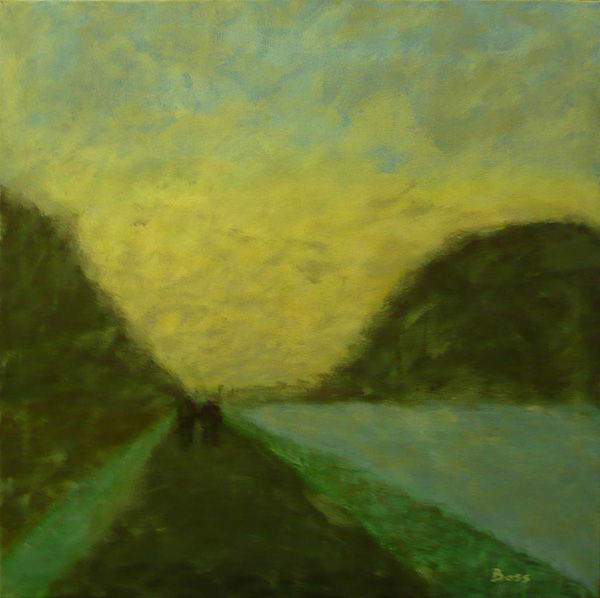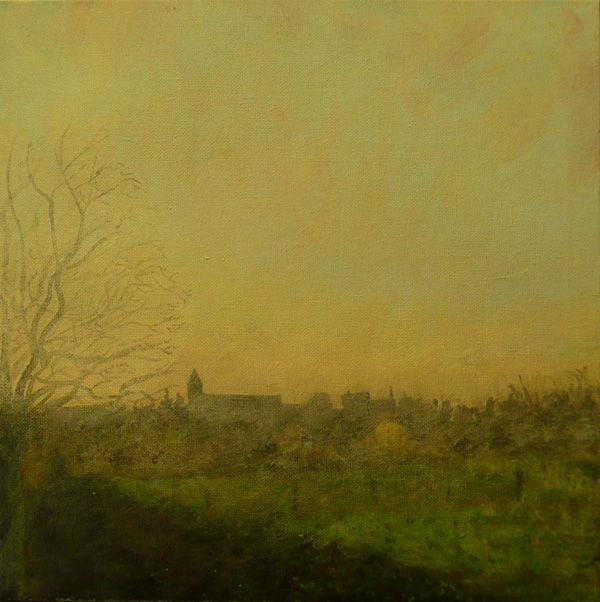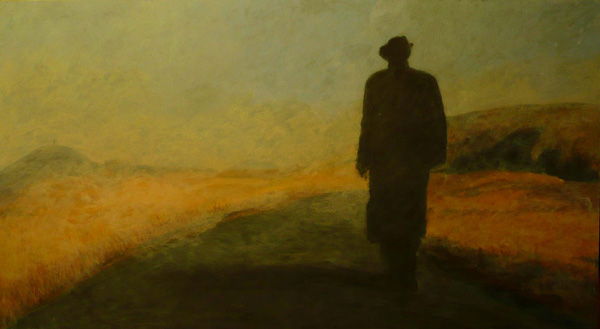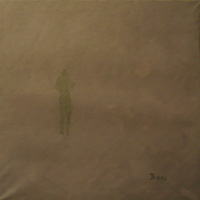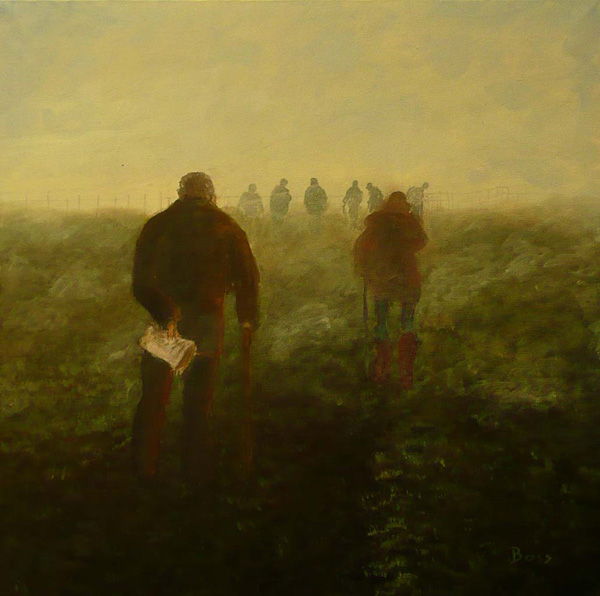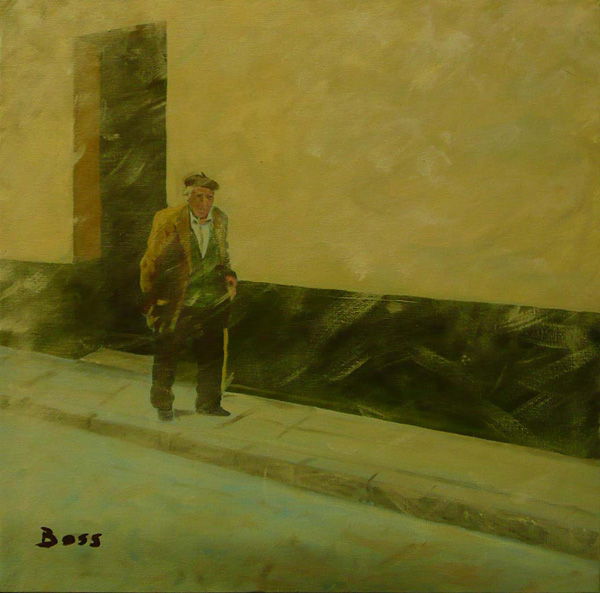The Wanderer
2013
Acrylic on canvas
50x50cm
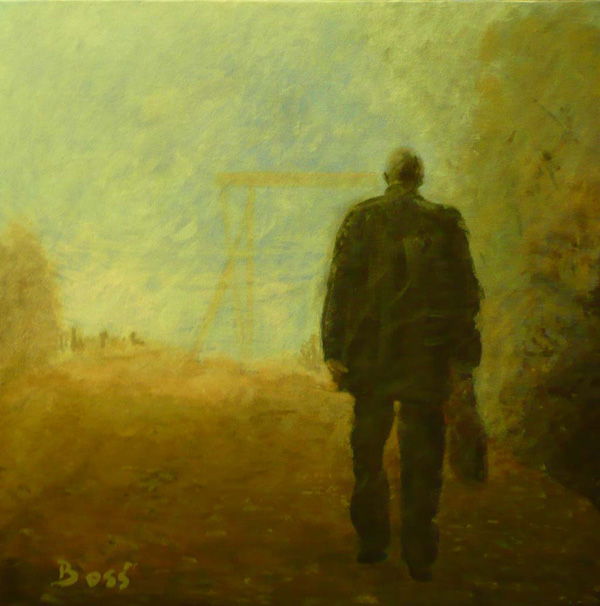
When watching over the shoulder of the protagonist of this painting, we can see a village or small town in the distance. To reach this, the man probably has to take a bridge. The man still has a long way to go. Is this town the final destination of the man? The title suggests not. We can’t find out much of the man who is turned with his back to us.
In some way the man doesn’t belong in this picture. His clothes and briefcase don’t suggest that he is a vagabond. On the other hand you don’t suspect an employee with briefcase at foot in this kind of desolate road, far away from civilization. You expect him on a busy train, queuing in a line of cars or walking on a hectic sidewalk of a city, targeted on his way to his office.
The mysterious atmosphere is amplified by the hazy brush strokes and the chiaroscuro. The canvas consists of pronounced dark and light parts. The border between dark and light is formed between the diagonal line from the right upper corner to the left bottom corner. Because of htis, the man is placed in the darker part, the destination in the lighter part. Because the man is on the foreground -and as a result bigger- he first draws the attention, but shortly after that, the eye is lead to the lighter horizon.
The title of the painting could be a reference to the painting with the same name of
Caspar David Friedrich. On this painting you can also see a sharp dressed man, seen from the back, staring over a see of mist. Here, also a strong light-dark contrast is present.
Or maybe it is a contemporary adaptation of an Old English poem about a wanderer who finally sees the light after long nostalgic musing?
Of maybe it is a reference to the
U2 song with the same name, which starts like this:
I went out walking
Through streets paved with gold
Lifted some stones
Saw the skin and bones
Of a city without a soul
I went out walking
Under an atomic sky
…
It would be a feat if Boss had all 3 references in mind when making this painting.
Wanneer we over de schouder van de protagonist van dit schilderij kijken, zien we in de verte een stad of dorp. Om deze te bereiken moet waarschijnlijk eerst nog een brug genomen worden. De man heeft nog een lange weg af te leggen. Is deze stad de eindbestemming van de man? De titel laat vermoeden van niet. Veel komen we niet te weten over de man doordat hij met de rug naar ons gekeerd is.
Ergens hoort de man niet thuis in dit totale beeld. Zijn kledij en tas laten vermoeden dat hij geen zwerver is. Anderzijds, een bediende met aktetas verwacht je niet te voet op een dergelijke desolate weg, ver verwijderd van de beschaving. Die vind je op een drukke trein, aanschuivend in de file of jachtig op een trottoir van een stad, doelgericht onderweg naar zijn kantoor.
De mysterieuze sfeer wordt nog versterkt door de wazige penseelstreken en het licht-donker contrast. Het doek is in een duidelijk licht en donker gedeelte opgedeeld. De scheidingslijn tussen licht en donker wordt gevormd door de diagonaal van de linker benedenhoek tot de rechter bovenhoek. Hierdoor staat de man in het donker, de eventuele eindbestemming in het licht. Doordat de man op de voorgrond staat en bijgevolg groter is, wordt hij eerst gezien, maar automatisch wordt het oog naar de horizon geleid.
De titel van dit werk zou een knipoog kunnen zijn naar het gelijknamige schilderij van
Caspar David Friedrich, waarop ook een deftig geklede man, vanop de rug gezien boven een zee van nevel staat. Ook hier is een sterk licht-donker contrast aanwezig.
Of is het een eigentijdse interpretatie van een Oudengels gedicht, waarbij de dwaler na lang nostalgisch gemijmer eindelijk het licht ziet?
Of is het een verwijzing naar de gelijknamige
U2 song, die zo start:
I went out walking
Through streets paved with gold
Lifted some stones
Saw the skin and bones
Of a city without a soul
I went out walking
Under an atomic sky
…
Het zou straf zijn mocht Boss die 3 referenties voor ogen hebben gehad.
(door P.O.)
 When watching over the shoulder of the protagonist of this painting, we can see a village or small town in the distance. To reach this, the man probably has to take a bridge. The man still has a long way to go. Is this town the final destination of the man? The title suggests not. We can’t find out much of the man who is turned with his back to us.
In some way the man doesn’t belong in this picture. His clothes and briefcase don’t suggest that he is a vagabond. On the other hand you don’t suspect an employee with briefcase at foot in this kind of desolate road, far away from civilization. You expect him on a busy train, queuing in a line of cars or walking on a hectic sidewalk of a city, targeted on his way to his office.
The mysterious atmosphere is amplified by the hazy brush strokes and the chiaroscuro. The canvas consists of pronounced dark and light parts. The border between dark and light is formed between the diagonal line from the right upper corner to the left bottom corner. Because of htis, the man is placed in the darker part, the destination in the lighter part. Because the man is on the foreground -and as a result bigger- he first draws the attention, but shortly after that, the eye is lead to the lighter horizon.
The title of the painting could be a reference to the painting with the same name of Caspar David Friedrich. On this painting you can also see a sharp dressed man, seen from the back, staring over a see of mist. Here, also a strong light-dark contrast is present.
Or maybe it is a contemporary adaptation of an Old English poem about a wanderer who finally sees the light after long nostalgic musing?
Of maybe it is a reference to the U2 song with the same name, which starts like this:
I went out walking
Through streets paved with gold
Lifted some stones
Saw the skin and bones
Of a city without a soul
I went out walking
Under an atomic sky
…
It would be a feat if Boss had all 3 references in mind when making this painting.
When watching over the shoulder of the protagonist of this painting, we can see a village or small town in the distance. To reach this, the man probably has to take a bridge. The man still has a long way to go. Is this town the final destination of the man? The title suggests not. We can’t find out much of the man who is turned with his back to us.
In some way the man doesn’t belong in this picture. His clothes and briefcase don’t suggest that he is a vagabond. On the other hand you don’t suspect an employee with briefcase at foot in this kind of desolate road, far away from civilization. You expect him on a busy train, queuing in a line of cars or walking on a hectic sidewalk of a city, targeted on his way to his office.
The mysterious atmosphere is amplified by the hazy brush strokes and the chiaroscuro. The canvas consists of pronounced dark and light parts. The border between dark and light is formed between the diagonal line from the right upper corner to the left bottom corner. Because of htis, the man is placed in the darker part, the destination in the lighter part. Because the man is on the foreground -and as a result bigger- he first draws the attention, but shortly after that, the eye is lead to the lighter horizon.
The title of the painting could be a reference to the painting with the same name of Caspar David Friedrich. On this painting you can also see a sharp dressed man, seen from the back, staring over a see of mist. Here, also a strong light-dark contrast is present.
Or maybe it is a contemporary adaptation of an Old English poem about a wanderer who finally sees the light after long nostalgic musing?
Of maybe it is a reference to the U2 song with the same name, which starts like this:
I went out walking
Through streets paved with gold
Lifted some stones
Saw the skin and bones
Of a city without a soul
I went out walking
Under an atomic sky
…
It would be a feat if Boss had all 3 references in mind when making this painting.
